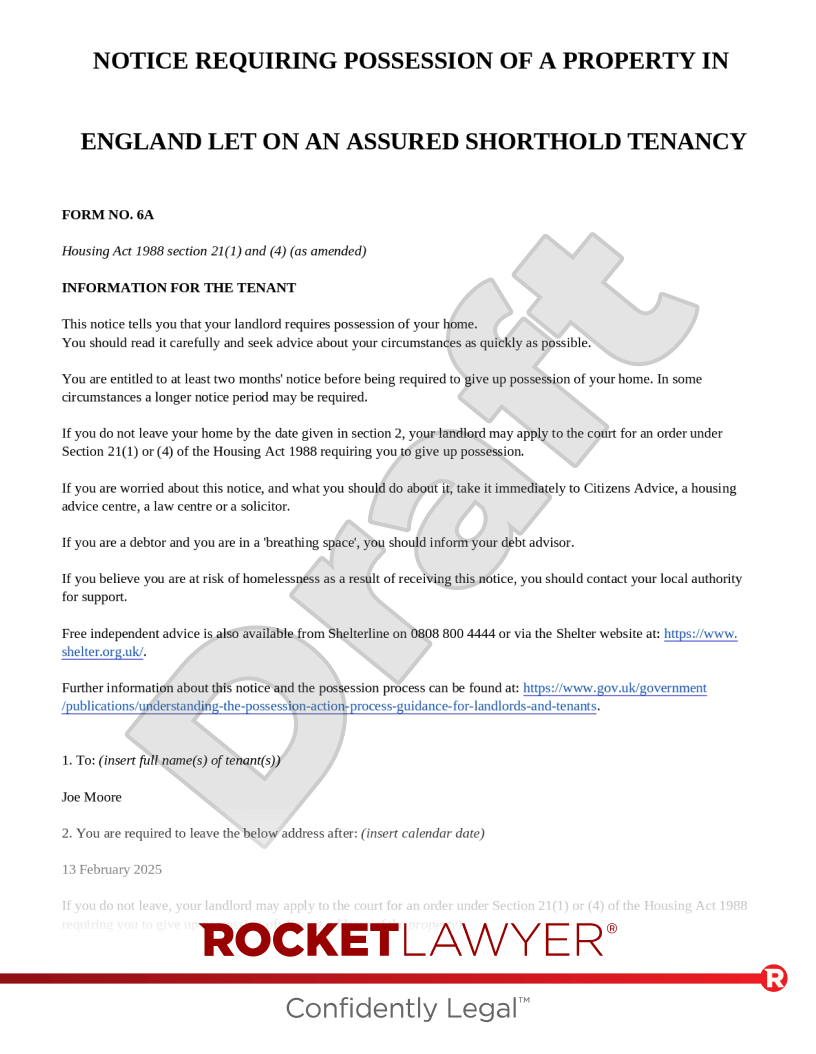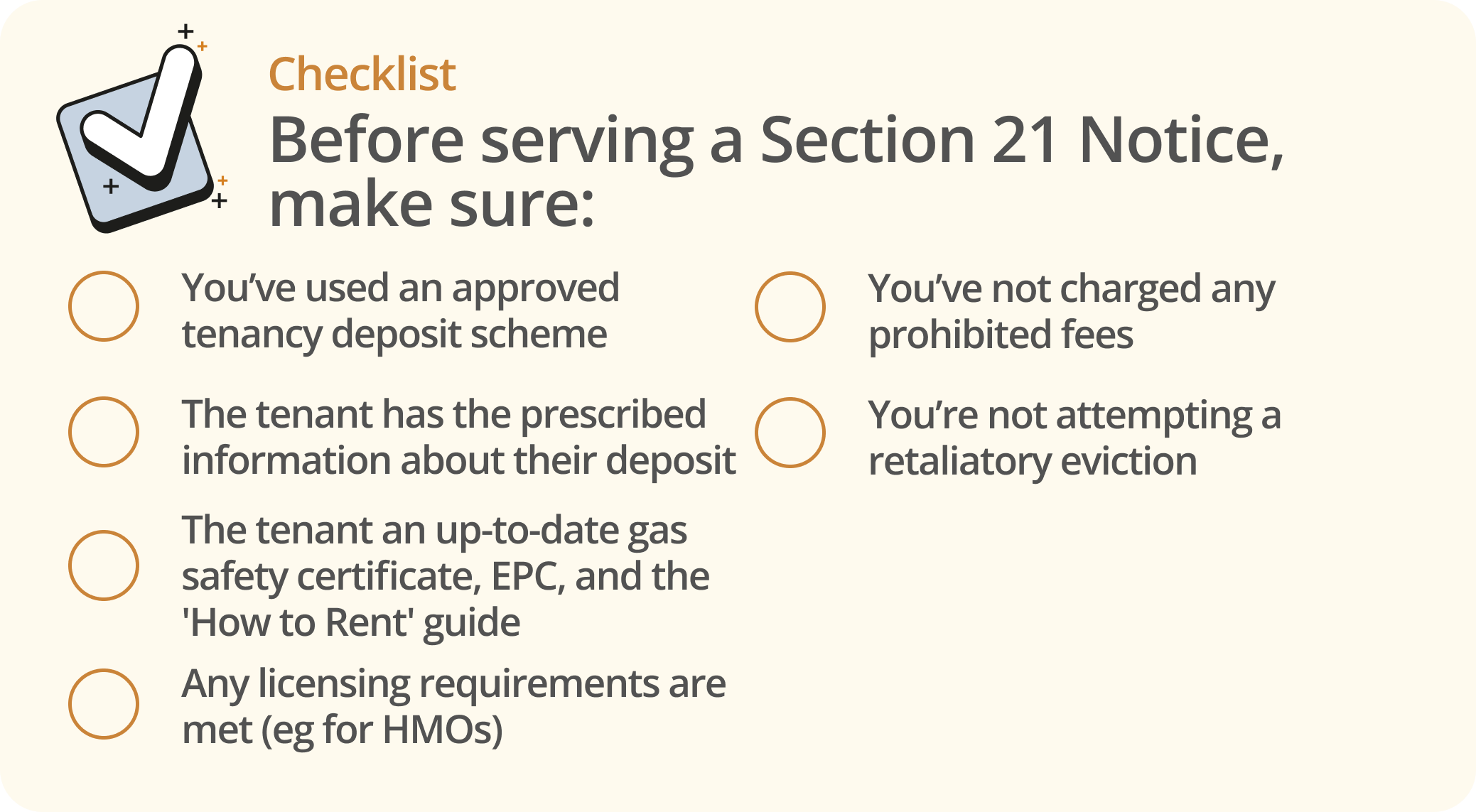MAKE YOUR FREE Section 21 (Form 6A) Notice for England

What we'll cover
What is a Section 21 Notice?
Section 21 Notices are formal notifications used to inform tenants that their landlord wishes to regain possession of the property they’re living in. Using Section 21 Notices is often referred to as ‘no fault’ eviction as landlords don’t need to give their tenants reasons for section 21 evictions.
For use in England only.
When should I use a Section 21 Notice?
Use this Section 21 (Form 6A) Notice:
-
when you want to regain possession of a property you’ve rented out
-
when the tenant is not at fault
-
for an assured shorthold tenancy (AST)
-
when you have not done anything as a landlord that may make a Section 21 Notice invalid
-
for properties located in England only
-
not within the first 4 months of a new tenancy
-
not when the tenant has made complaints about the condition of the property and, consequently, eviction may constitute retaliatory eviction
Sample Section 21 (Form 6A) Notice for England
The terms in your document will update based on the information you provide
NOTICE REQUIRING POSSESSION OF A PROPERTY IN
ENGLAND LET ON AN ASSURED SHORTHOLD TENANCY
FORM NO. 6A
Housing Act 1988 section 21(1) and (4) (as amended)
INFORMATION FOR THE TENANT
This notice tells you that your landlord requires possession of your home.
You should read it carefully and seek advice about your circumstances as quickly as possible.
You are entitled to at least two months' notice before being required to give up possession of your home. In some circumstances a longer notice period may be required.
If you do not leave your home by the date given in section 2, your landlord may apply to the court for an order under Section 21(1) or (4) of the Housing Act 1988 requiring you to give up possession.
If you are worried about this notice, and what you should do about it, take it immediately to Citizens Advice, a housing advice centre, a law centre or a solicitor.
If you are a debtor and you are in a 'breathing space', you should inform your debt advisor.
If you believe you are at risk of homelessness as a result of receiving this notice, you should contact your local authority for support.
Free independent advice is also available from Shelterline on 0808 800 4444 or via the Shelter website at: https://www.shelter.org.uk/.
Further information about this notice and the possession process can be found at: https://www.gov.uk/government/publications/understanding-the-possession-action-process-guidance-for-landlords-and-tenants.
1. To: (insert full name(s) of tenant(s))
2. You are required to leave the below address after: (insert calendar date)
If you do not leave, your landlord may apply to the court for an order under Section 21(1) or (4) of the Housing Act 1988 requiring you to give up possession of: (insert address of the property)
,
3. If your landlord does not apply to the court within a given timeframe this notice will lapse. If you are entitled to more than 2 months', notice your landlord can rely on this notice to apply to the court during the period of 4 months commencing from the date specified in section 2 above. In all other cases, your landlord can rely on this notice to apply to the court during the period of 6 months commencing from the date this notice is given to you.
4. Name and address of landlord or landlord's agent:
(To be completed in full by the landlord, or, in the case of joint landlords, at least one of the joint landlords, or by someone authorised to give notice on the landlord's behalf.)
| Signed | |
| Name | |
| Address | |
| Telephone number |
| Signed | |
| Name | |
| Address | |
| Telephone number |
Capacity (please tick): landlord
joint landlord(s)
landlord's agent
| Date |
Contains public sector information licensed under the Open Government Licence v3.0. Crown copyright. Published by Rocket Lawyer, 2024
About Section 21 Notices
Learn more about making your Section 21 Notice
-
How to make a Section 21 Notice
Making your Section 21 Notice online is simple. Just answer a few questions and Rocket Lawyer will build your document for you. When you have all the information about your Notice prepared in advance, creating your document is a quick and easy process.
You’ll need the following information:
The tenant's details
-
What is the tenant’s name? If there are joint tenants, what are all of their names?
Property details
-
What is the address of the property you’ve rented out?
The notice
-
When will the Section 21 Notice expire?
-
-
Common terms in a Section 21 Notice
Section 21 Notices are a vital part of the eviction process. They ensure clear communication between a landlord and a tenant and, when necessary, enable landlords to start possession proceedings. To do this, this Section 21 Notice template includes sections and terms including:
-
‘Form No. 6A’ - this identifies the Notice as containing everything necessary to meet the format that legally must be used to serve Section 21 Notices in England. Underneath this is a reference to the parts of section 21 of the Housing Act 1988 that facilitate Section 21 Notices
-
information for tenants - this section informs the tenant that their landlord is seeking possession of their home (ie by evicting them). It then sets out some tenants’ rights related to Section 21 Notices, some information about things that might happen, and things that tenants may do in relation to the process. This includes:
-
the notice periods the tenant is entitled to
-
who the tenant can contact for advice about the eviction process (including any risk of homelessness) and some assistance they can seek, such as Breathing Space
-
the possibility that the landlord will apply for a possession order, which requires them to give up possession of the property
-
-
details - the Notice then sets out who the tenant is (or who the joint tenants are) and which property the Notice is for. It sets out after which date the tenant is being asked to leave the property
-
signatory and signatures - lastly, the Notice provides space for the landlord (or multiple joint landlords or an agent of the landlord(s)) to sign the Notice
You should usually not alter this Section 21 Notice template when you make your Notice. To be valid, your Notice must follow the form 6A format provided by the Government, which this template is modelled on.
If you do want your Notice to include further or more detailed provisions (eg more information for tenants about their rights and options), you can edit your document. However, if you do this, you may want a lawyer to review the document for you (or to make the changes for you) to make sure that your modified Section 21 Notice complies with all relevant laws and formats and meets your specific needs. Use Rocket Lawyer’s Ask a lawyer service for assistance.
-
-
Legal tips for landlords
Make sure your Section 21 Notice is valid
There are various poor practices which, if a landlord has engaged in, will make any Section 21 Notice that they serve invalid (ie ineffective). It’s also important to make sure you don’t engage in any of these practices (eg charging prohibited tenants’ fees) as doing so is often against the law. Some things to keep in mind to ensure you serve a valid Notice are:
-
if your property is rented by joint tenants, you must include all of the joint tenants’ names in your Section 21 Notice
-
you must provide long enough notice to comply with the law. When calculating this, make sure you take into account any postage times
For more information, read the FAQ ‘When is a Section 21 Notice valid?’.
Make sure you comply with broader real estate law (or ‘housing law’) when dealing with your tenant
There are a lot of legal protections in place to help ensure that residential tenants are treated fairly. As a landlord, if you’re planning to evict a tenant, you should make sure you adhere to legal requirements like notice periods. For more information, read Rocket Lawyer’s guidance including:
Consider your tenant’s situation
Serving an eviction notice on somebody without warning or obvious reason can be stressful and upsetting for a tenant. To minimise this, it’s good practice to discuss the situation with your tenant before serving a Section 21 Notice. You may, for example, explain why you’re planning to evict them and let them know that a Notice will be arriving. You could discuss alternative options with your tenant. For example, you could agree on a Rent repayment plan if the tenant is just starting to get behind in rent or you could create a new Tenancy agreement with terms suited to your situation.
Understand when to seek advice from a lawyer
In some circumstances, it’s good practice to Ask a lawyer for advice to ensure that you’re complying with the law and that you are well protected from risks. You should ask for advice if:
-
you want to evict a commercial tenant
-
a tenant's deposit wasn't protected or another of the requirements for a valid Section 21 Notice has not been met
-
your tenant has complained about the condition of the premises or common parts of the property and you’re not sure if serving a Section 21 Notice now may constitute retaliatory eviction
-
you want to discuss options other the eviction to solve an issue you’ve having with your tenant
-
Section 21 Notice FAQs
-
What’s included in a Section 21 Notice?
This Section 21 Notice template covers:
-
the Notice’s purpose of ending a tenancy let on an assured shorthold basis
-
the notice period and last day of the tenancy
-
the tenant’s options, rights, and potential sources of advice
-
who is serving the Notice (ie one landlord, joint landlords, or the landlord's agent)
-
-
Why do I need a Section 21 Notice?
It is illegal for landlords of ASTs to take possession of a property from their tenant without following the proper procedures. Taking possession legally requires a landlord to serve and abide by a valid eviction notice, except in some situations, in which the tenant agrees to end a tenancy (ie surrendering a tenancy).
If you want to end a tenancy and none of the Section 8 notice grounds for eviction apply, you should serve a Section 21 Notice to start the process of repossessing the property.
-
Can this form be used for tenancies that started before and after 1 October 2015?
This Section 21 Notice template meets the requirements for a Section 21 Notice’s contents. These requirements are set out in the Government’s ‘form 6A’. When form 6A was released it only had to be used for tenancies created on 1 October 2015 or later. The format must now be used for all ASTs in England, so you can use this template for an AST created on, before, or after 1 October 2015.
-
How much notice can I give tenants when using a Section 21 Notice?

A Section 21 Notice must generally give a tenant 2 months’ notice to leave the property. This applies when the Notice is served during a fixed-term tenancy (with a notice period set to end after the fixed-term ends) or during a statutory periodic tenancy. A statutory periodic tenancy is the type of tenancy that arises automatically at the end of a fixed-term if a tenancy agreement doesn’t provide otherwise. If the initial tenancy was an AST, this will be too.
A contractual periodic tenancy is the type of tenancy that arises either when a tenancy is periodic from the start (ie by agreement) or when a fixed-term tenancy ends and its tenancy agreement states that, at the end of the fixed-term, a periodic tenancy will arise. If you serve a Section 21 Notice during a contractual periodic tenancy, the length of notice that must be given is the longer of:
-
2 months, or
-
one period of the tenancy (eg 6 weeks or 3 months). For a tenancy with a yearly period, 6 months’ notice is adequate
You can choose to give tenants more notice to leave a property. If you know that you need your property to be vacant by a particular date in the future, it can demonstrate respect and can help your tenant to make arrangements for new accommodation if you discuss the situation with them and serve a Section 21 Notice earlier, with a longer notice period.
For more information, read Repossessing property - section 21 notices.
-
-
When can I serve a Section 21 Notice?

A Section 21 Notice can be served either:
-
during a periodic tenancy, or
-
after or in anticipation of the end of a fixed-term tenancy
Section 21 Notices cannot be served during a fixed-term tenancy unless the notice period given ends after the end of the fixed-term. The Notice should not expire on the last day of the fixed-term.
There may be an exception if a Section 21 Notice is used to activate a break clause (ie a clause allowing one or either party to end the tenancy early) in the tenancy agreement, and using a Section 21 Notice to do this adheres to the requirements set out by the break clause for its activation.
You cannot serve a Section 21 Notice within the first four months of a tenancy. This applies to fixed-term tenancies and newly created contractual periodic tenancies. If a tenancy is renewed or becomes a periodic tenancy at the end of a fixed-term, you don’t need to wait 4 months from the start of this consequent tenancy to serve a Section 21 Notice.
For more information, read Repossessing property - section 21 notices.
-
-
What happens after a Section 21 Notice is served?
A Section 21 Notice does not itself end a tenancy. The Notice is an important and vital first step, but after it’s been correctly served, more must happen for the tenancy to end.
When a tenant receives a valid Section 21 Notice, they should move out by the date specified in the Notice. This will end the tenancy.
However, if this doesn’t happen, to end the tenancy the landlord must:
-
obtain a possession order, and
-
enforce this order if necessary with a warrant of possession
A landlord must start legal proceedings within certain time limits in order to obtain a possession order. These depend on the Section 21 Notice’s notice period:
-
if the Notice gives more than 2 months’ notice, a claim must be started within 4 months after the end of the notice period
-
otherwise, a claim must be started within 6 months after the date of service (see the Make it legal checklist for information on the date of service)
For more information on this process, read Enforcement of possession orders.
The eviction process can be complex. For example, programmes like the Debt Respite Scheme (Breathing Space) are available to help individuals struggling to meet debts (eg their rent payments). Breathing space temporarily suspends evictions. You can Ask a lawyer for help navigating complex situations like this.
-
-
When is a Section 21 Notice valid?
Section 21 Notices will generally be valid if they meet all of the requirements for the Notice’s contents, service, and timing. There are, however, things that landlords do or don’t do that can invalidate any Section 21 Notice they make.
Why would a Section 21 Notice be invalid?
A Section 21 Notice will usually not be valid, even if correctly served, if certain circumstances have occurred.

Some of the key situations that invalidate a Section 21 Notice are:
-
the tenant's deposit is not held in a Government-approved tenancy deposit scheme
-
the tenant has not received the prescribed information relating to their deposit
-
the tenant has not received copies of an up-to-date gas safety certificate, the property’s Energy Performance Certificate (EPC), and the Government's 'How to Rent' guide
-
the rented property is not properly licensed, if such is required by the relevant local authority or if an HMO licence is required
-
you have charged your tenant a prohibited fee (eg by keeping a holding deposit)
-
your eviction constitutes a retaliatory eviction (ie you’re serving an eviction notice after the tenant has complained about the condition of the property and the local authority has served a relevant notice, such as an improvement notice)
If a tenant has provided an email address and has agreed to accept documents at this address, you can deliver documents like an EPC and the How to Rent guide to this email address. If not, you (or your agent) should provide paper copies. For more information, read Repossessing property - section 21 notices.
-
-
Are Section 21 Notices changing?
The UK Government has announced intentions to end the use of Section 21 Notices in England (ie ‘no fault eviction’) during the current parliamentary session. Section 8 notices will still be available for evicting tenants with good reason. For instance, because they have not paid rent or have damaged the property. For more information on the anticipated changes, read The end of ‘no fault’ eviction.

Our quality guarantee
We guarantee our service is safe and secure, and that properly signed Rocket Lawyer documents are legally enforceable under UK laws.
Need help? No problem!
Ask a question for free or get affordable legal advice from our lawyer.





